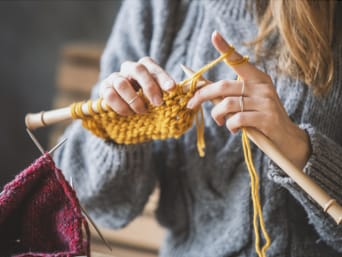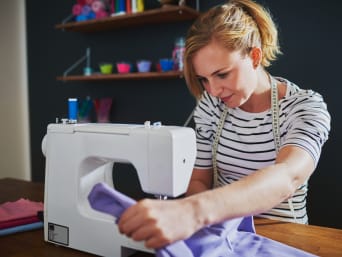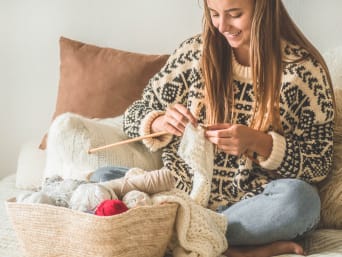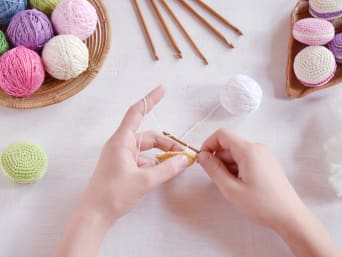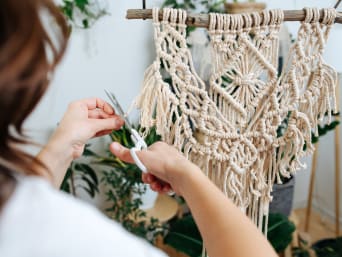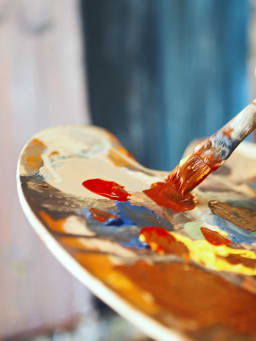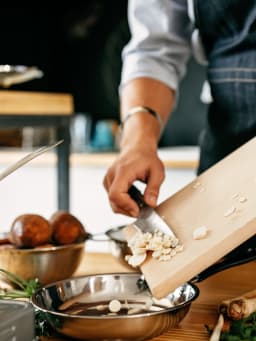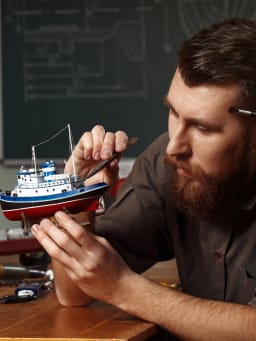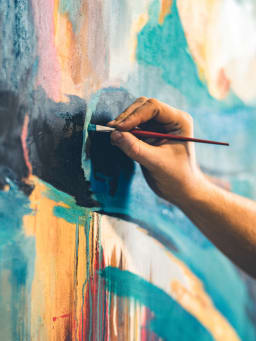Handicrafts: from crochet to knitting and sewing
If you are creative, skilled with your hands and like to create lasting works of art from fabrics, wool or yarns, handicrafts are a great way to relax and get away from it all. From crochet to knitting, sewing and macramé, the world of homemade fashion and decorations is wide open and just waiting for you to discover it. To help you find the right pastime in the plethora of handicrafts, here are four fun and trendy hobbies you should try.
Learn to sew: sew, repair, & upcycle old clothes
The sewing machine tirelessly rattling away is the sound of pure bliss for many passionate sewers. In the blink of an eye, unique pieces of fabric come together to form homemade garments that you have designed exactly how you like. You can create clothes for yourself or make cute things for children and babies, or simply alter, decorate, and repair your own clothes.
If you would like to learn how to sew, you can find many courses on the internet and/or in your town/city. For example, you can sign up for sewing courses at adult education centres, tailor shops, or fabric shops and learn the basics very easily. In addition, there are many tutorials on YouTube that can teach you new techniques. Another option is to exchange ideas with other hobby sewers. You can find various forums, websites, or social media channels where you can contact new people. It is also worth visiting local sewing cafés or fabric and creative fairs.
To help you get started with this fantastic hobby, you should start small and then slowly build up your skills. Some examples of small projects to get started are:
Mobile phone cases
Simple shopping bags
cushion covers
placemats
pin cushions
Woven fabrics made of cotton are easy to sew, so they are good for beginners. You can find some great instructions and patterns online or in (online) creative markets.

Upcycling projects are also a great place to start for beginners. For example, you can turn old clothes or fabric scraps into DIY cleaning cloths or chic bread bags in no time at all. Sewing is a great skill to have, and it can help you live more sustainably.
All you need to get started with a sewing hobby is:
A sewing machine for beginners
(Tip: normal, high-quality sewing machines with a smaller programme selection are a good place to start).Spare machine needles
Various fabrics or old clothes
Tailor’s chalk
Greaseproof paper (for transferring patterns)
Fabric scissors
Pins
Sewing thread
A measuring tape
A seam ripper
Of course, you can expand your basic equipment over time as you need it. The important thing is to take the first step and start sewing. Even if your first project isn’t perfect, you’ll get better with time and soon you’ll be designing your own fashion items.
What is the difference between crochet and knitting?
Crochet and knitting are both handicraft techniques that allow you to create a variety of works of art from wool. From warm hats, fluffy socks and cosy jumpers to decorative blankets or even toys, you can try your hand at many different projects using wool and needle(s). But what’s the difference between crochet and knitting? We’ll give you a brief introduction to both hobbies.
Knitting for beginners: create cosy clothes & accessories in no time
Knitting involves the use of two long, straight needles to work a wool yarn into a nice, loose fabric. To do this, pick up each of the stitches with one knitting needle and knit them off again with the other needle. The individual loops intertwine to form a soft and elastic weave that is perfect to make garments out of. For example, you can create soft jumpers and cardigans in your favourite colour, warm hats and scarves for the winter, or cosy baby socks for the youngest in the family.
If you want to learn to knit, you should start with easy projects with a simple pattern and a clear shape, like a scarf or a small blanket. When choosing the right needles, beginners can opt for thicker wooden or bamboo needles. This will help you to knit more quickly, you will be able to grip the needles better and the stitches will not slip off the needle so easily.

When you are learning to knit, you may prefer to use circular needles. These allow you to put your project away without the stitches slipping off and getting lost. When using circular needles, make sure that the transition between needle and cable is smooth so that your wool does not get stuck.
All you need to get started with knitting:
Knitting needles
Wool
A measuring tape
Scissors
Darning needles
Stitch markers if necessary
Tip: Choose wool that matches your knitting needle size. You will find information on the label of your ball of yarn.
You can find instructions and valuable tips on knitting online in forums and blogs or by taking part in (online) seminars and workshops. These are offered in places like your local needlework circle, adult education centre, or (online) creative shops.
Crochet for beginners: make your own warm hats, decorative doilies, or amigurumi
In contrast to knitting, you only need one needle for crochet. It’s long and has a little hook at the end so you can easily pick up the stitches and knot them. When you learn to crochet, you work stitch by stitch, until you have a strong fabric. Because you only have one stitch on your needle at a time, it is usually easier to learn crochet for beginners. However, the finished fabric is not as loose and elastic as a knitted one. The tight crochet stitches are great for decorative tablecloths, cosy blankets, stylish potholders, shopping nets, or even crocheted toys (also called amigurumi).
If you want to learn to crochet, start with a simple tutorial. A good starting point for beginners are things like potholders, a simple scarf, or a simple hat. If you want to try your hand at amigurumi, choose dolls that are as round and simple possible, for example, round birds, snowmen, or simple teddy bears. The best way to learn to crochet is with a thick needle. It should be between 3.5 and 4.5 mm wide and made of metal, as these needles won’t break so quickly.
To be able to start crocheting right away, you need this small basic equipment:
A crochet hook
Wool
A measuring tape
Scissors
Darning needles
Stitch markers (if necessary)
For amigurumi additionally: cotton wool & safety eyes
Tip: It is best to choose yarn that matches the size of your crochet hook. You will find information on the label of your ball of yarn.
You can find crochet instructions on forums, blogs, and YouTube, as well as in bookshops and creative shops. Handicraft clubs or (online) creative shops also offer workshops that can help you learn to crochet.
Homemade macramé: Try out this trendy hobby and learn macramé knots
Macramé has taken the handicraft world by storm in recent years. More and more handicraft lovers are now knotting trendy wall hangings, stylish shoulder bags, cute doilies, beautiful cushion covers, and decorative plant hangings. The technique originates from the Orient and is very easy to learn. You only need to master a few basic knots and you can start making macramé right away.
The most important thing in macramé is the yarn. Yarns can be divided into three categories:
single-twisted
triple-twisted
braided yarns
Twisted yarns are twisted together to form a thick cord. This makes them very strong and allows you to comb out the ends or make tassels. Braided yarns, on the other hand, cannot be combed out, but they can be stretched and usually make finished macramé work look “neater”. In addition to the type of yarn, you should also choose the right thickness. The thicker your yarn, the larger and coarser the pattern will be. Thick yarns are good for wall hangings and fine yarns for jewellery.
If you want to make your first macramé right away, you don’t need much. This is the equipment you need for macramé:
Macramé yarn
Scissors
A measuring tape
A pole or branch (if you want to make a wall hanging)
A macramé board or a clipboard if you want to make jewellery
Beads, baubles, rings, or pendants (if needed)
Of course, you can teach yourself the most important techniques with the help of YouTube videos. But you can also take part in workshops and expand your macramé skills under expert guidance. The workshops allow you to meet other macramé enthusiasts and make new friends.

To get started quickly you can find many beginners macramé kits in creative shops and online shops. The kits contain matching yarn, instructions, and accessories as a complete set and so that you can make your first macramé at your leisure.
Conclusion: crochet, macramé, sewing and knitting as a hobby
When you pursue handicrafts as a hobby, you can focus completely on your new work of art and forget the world around you. This helps you to relax and find a balance in your sometimes stressful everyday life. In addition, handicrafts promote creative and analytical thinking, which can help you find ideas and solve problems in everyday life.
______________________________________________
Resources and further information:
https://crazylittleprojects.com/sewing-for-beginners-learn-to-sew/
(Last accessed on 23.11.2023)
https://curiouscraftstudio.com/5-easter-macrame-tutorials/
(Last accessed on 23.11.2023)
https://www.thesprucecrafts.com/differences-between-knitting-and-crochet-4077447
(Last accessed on 23.11.2023)
The image sources in this text are in chronological order:
Cover photo: iStock.com/LukaTDB
1. Image in text: iStock.com/FlamingoImages
2. Image in text: iStock.com/Anastasiia Stiahailo
3. Image in text: iStock.com/Oksana_S
4. Image in text: iStock.com/KuznetsovDmitry
